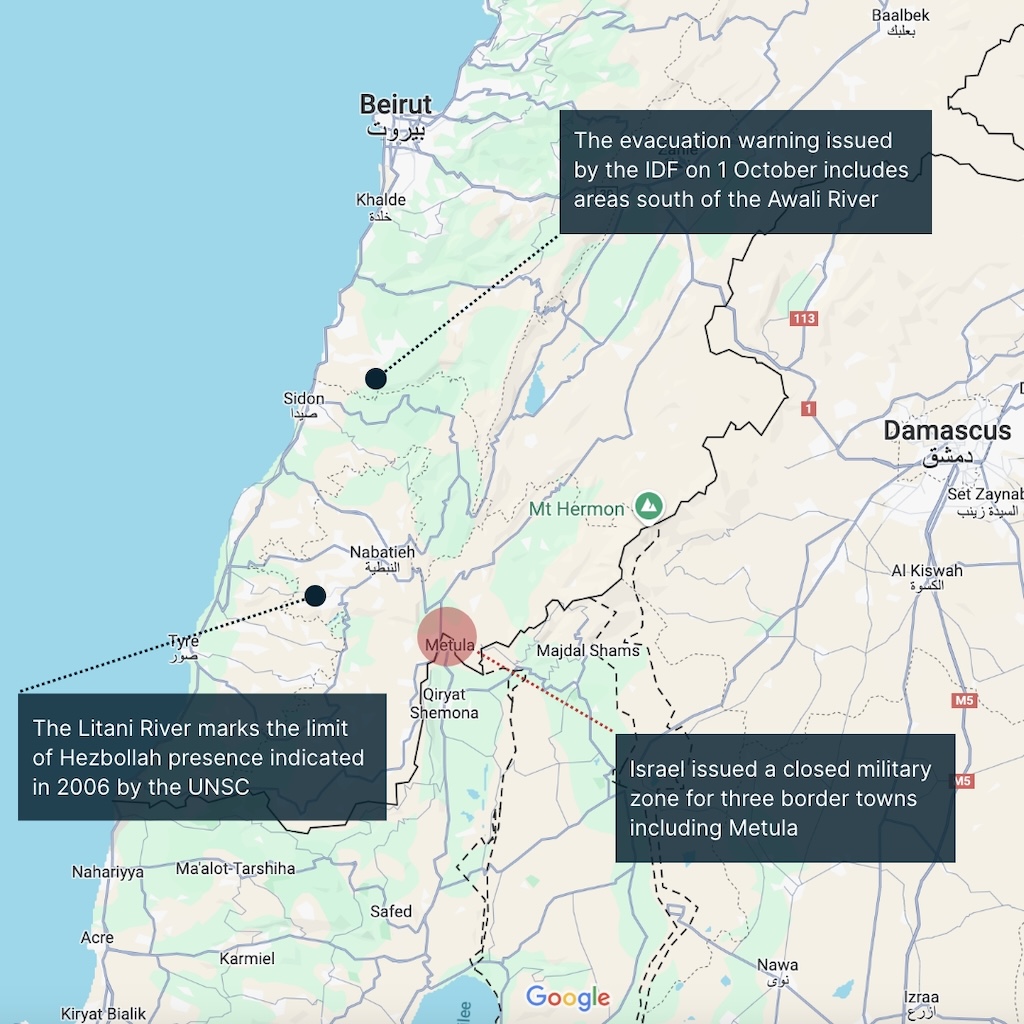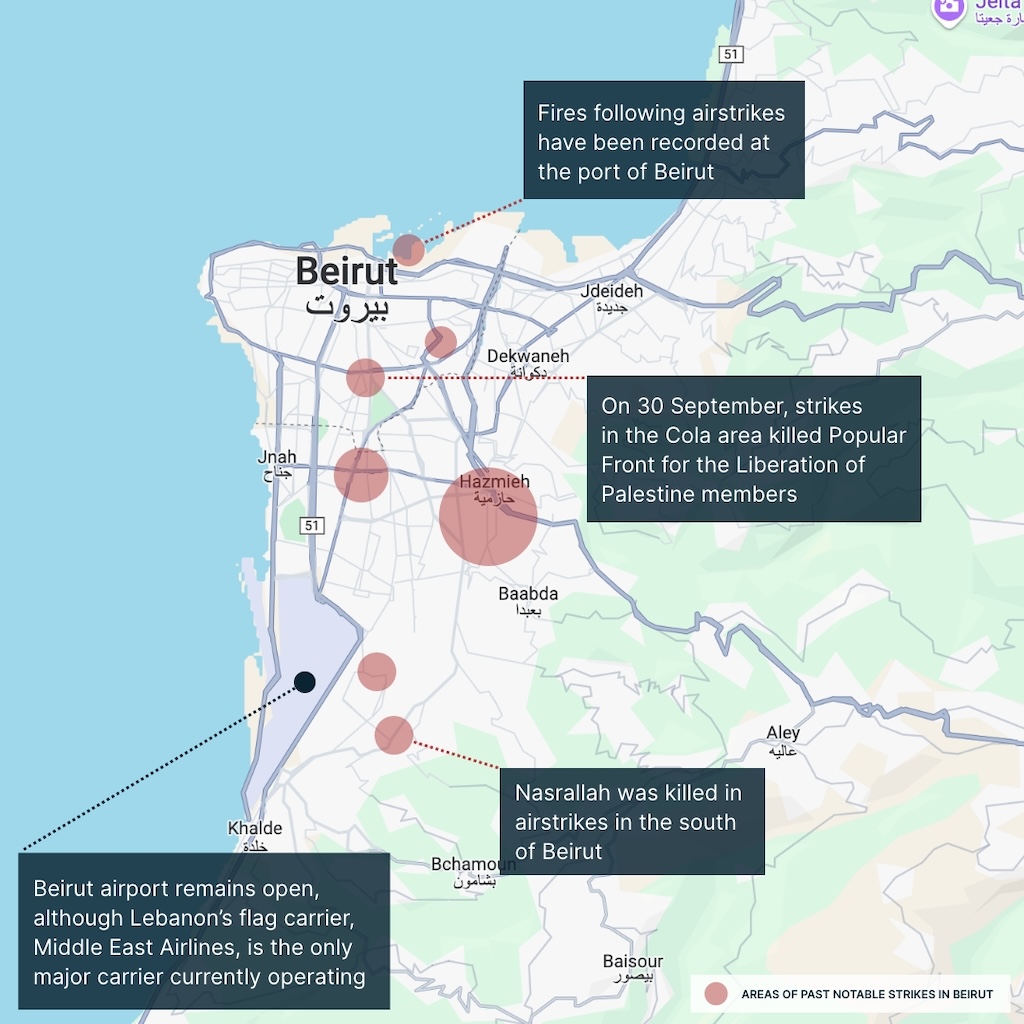Alert Plus: IDF Launches Ground Offensive in Southern Lebanon

Escalation in the Israel-Lebanon Conflict: Ground Operations and Airstrikes
Intelligence cut off: 12:00 GMT 2nd of October 2024
Shortly after 11:00 pm (local time) on 30 September, the Israel Defense Forces (IDF) launched what they described as a “targeted and delimited ground operation in southern Lebanon”, aimed against “terrorist targets and infrastructures of Hezbollah […] that pose an immediate and real threat to Israeli settlements on the northern border”. The 98th division, which was previously deployed in Gaza and was recently moved to the Israeli-Lebanon border, is spearheading the operations. On the morning of 1 October, IDF officials issued an evacuation order for 25 villages in southern Lebanon. The order includes a call for residents to move north of the Awali River, approximately 50km north of the international border. As of the time of writing, available OSINT shows that IDF operations have been limited, with no attempts at penetrating deep into Lebanese territory.
Israeli Air Force (IAF) strikes on Beirut and other parts of the country have continued, prompting severe transport disruptions and hundreds of casualties since mid-September. IDF units are currently also engaged in operations to clear Hezbollah tunnels near the Israel-Lebanon border. The high volume of strikes has also caused a mass displacement of Lebanese residents, with some government figures assessing that up to a million individuals have been internally displaced.
On the afternoon of 1 October, Iran launched a two-wave ballistic missile attack on targets throughout Israel, with reportedly at least 180 missiles being used. Israeli missile defence forces, as well as IAF and allied American and Jordanian air force units, contributed to the interception of the majority of the Iranian projectiles. Nevertheless, this attack was likely more successful at penetrating Israeli defences that the previous large-scale strike in April. Geolocated footage shows multiple missiles impacting areas near sensitive military targets, including the Mossad Headquarters, although no significant damage has been reported as of 2 October 11:00 (BST). The attacks resulted in only one confirmed casualty, a Palestinian civilian which was killed by debris near Jericho, in the West Bank.
Around the time of the reports of the first wave of missiles, two individuals carried out a gun and knife attack in Jaffa, south Tel Aviv, killing six and wounding at least seven. The perpetrators were killed by responding security forces. No Palestinian or international groups have claimed responsibility for the attack.

South Lebanon

Areas of Past Notable Strikes in Beirut
SOLACE GLOBAL COMMENT
Hezbollah Leadership Targeted as Israel Intensifies Military Operations in Lebanon
The ground operations follows weeks of asymmetric warfare, cross-border exchanges and airstrikes in Lebanon. On 17-18 September, the simultaneous explosion of thousands of pagers and other communication devices, highly likely orchestrated by Mossad, injured or killed at least 3,500 Hezbollah members and was likely shaping activity prior to a wider offensive.
From 23 September, the IAF targeted thousands of Hezbollah facilities, assets and units throughout Lebanon, including in Beirut and in the group’s northern stronghold, the Bekaa Valley. On 27 September, a massive IAF strike in the Dahieh area of south Beirut killed Hezbollah Secretary General Hassan Nasrallah, Ali Karaki, the commander of Hezbollah’s southern front, other members of Hezbollah’s senior leadership, and Iranian Islamic Revolutionary Guard Corps (IRGC) commander Abbas Nilforoshan.
Before the invasion, Israeli officials rejected a 21-day ceasefire deal proposed by the US, France, and other regional powers. The operations in Lebanon have been accompanied by further statements concerning the Netanyahu administration’s commitment to continuing operations until its strategic goals are reached.
The Iranian strike also follows a period of escalation. The large missile and drone barrage in April was carried out in response to highly likely Israeli strikes on Iranian diplomatic assets in Damascus, which resulted in the death of senior IRGC officials. Tehran vowed to retaliate after the wave of decapitation attacks carried out by Israel in the late summer, which killed key “Axis of Resistance” leaders, among them Hamas political bureau chairman Ismail Haniyeh, who was killed in a likely Mossad operation in Tehran. However, newly elected Iranian President Pezeshkian initially stated that Iran would refrain from attacking Israel while ceasefire negotiations continued.
Israeli officials have threatened to retaliate for the Iranian strikes. IDF forces at the Lebanon border have increased since the strikes, with elements of the 36th division also being deployed, likely in support of future operations.
SOLACE GLOBAL ANALYSIS
Implications of IDF Operations for Regional Stability and Security
The IDF’s ground offensive has likely been timed to exploit the current lack of command and control (C2) within Hezbollah which has been achieved through a series of high-profile strikes on the group’s senior leadership.
In September, the Netanyahu administration added the return of Israeli citizens to settlements near the Israel-Lebanon border to their list of stated war aims. The significant degradation of Hamas forces in the Gaza Strip following a year of conflict has also almost certainly allowed Tel Aviv to shift its focus to the north. Israeli officials almost certainly assess that a reduced ground force, combined with a constant threat of airstrikes, will be sufficient to prevent Hamas from reforming units capable of significantly threatening IDF forces in Gaza.
IDF operations are highly likely aimed at destroying Hezbollah assets in the south of Lebanon and preventing the group from targeting north Israel. While Hezbollah maintains some long-range weapons systems, much of the group’s arsenal has a maximum range of ~40km. IDF operations will likely seek to force Hezbollah to retreat north of the Litani River, as per the 2006 UN Security Council Resolution 1701. On 1 October, the IDF announced that it had destroyed at least 700 Hezbollah targets in southern Lebanon as part of a previously undisclosed series of covert operations. The latest operations are highly likely meant to expand these efforts, by employing conventional assets.
It is unlikely that the IDF will commit to a long-term occupation of southern Lebanon, which would entail high political and economic costs as well as a high rate of casualties. The IDF’s main objective is likely to clear Hezbollah forces and weapons from areas immediately adjacent to the border. However, deeper raids and strikes aimed at high-value targets like ammo depots, C2 posts, logistic nodes and launch sites are highly likely.
There is a realistic possibility that part of the Israeli efforts will be aimed at arming and supporting Lebanese militias – particularly Christian ones – that are opposed to Hezbollah. Over the past year, sectarian tensions between Shias, Sunnis, and Maronite Christians have increased in Beirut, and Israeli special operations may seek to leverage these to decrease Hezbollah’s political influence in Lebanon.
The latest attack by Tehran is likely to allow Israeli forces the political justification to increase strikes and ground operations targeting Hezbollah in Lebanon, as well as strikes on other regional Axis of Resistance members. Israeli forces may seek to capitalise on the recent decapitation strikes to significantly degrade Hezbollah’s manpower and, especially, weapons stocks as a prelude to a UN-mediated deal on its northern border. An Israel-Hamas ceasefire deal, remains, as of now, extremely unlikely, especially due to the approaching 7 October anniversary, whose political significance likely makes such a deal unthinkable for the Israeli leadership.
Israeli forces will almost certainly retaliate for Iran’s attack. However, it is highly likely that retaliatory strikes targeting Iranian assets or territory will be limited to avoid further escalation and meant at re-establishing deterrence. There is a realistic possibility that Israeli forces will opt to strike Iranian officials and assets in Iraq or Syria, including IRGC members. Moreover, Israeli strikes could also target military targets, including missile launch sites and air defence stations, in Iranian territory, as well as strategic objectives like oil extraction facilities and refineries.
Finally, there is a realistic possibility of Israeli strikes targeting Iranian nuclear programme facilities. While such a course of action has been advocated by “hawkish” elements of the Israeli government, as well as some allied political figures, such a move would highly likely be opposed by London, Washington, and Brussels, as it poses an obvious threat to the possible resumption of nuclear negotiations, which Pezeshkian has repeatedly called for in his recent speech at the UN General Assembly.
On 1 October, at approximately 10:00 (BST), Israeli officials reported that IDF forces have intensified raids in the West Bank, and especially Hebron, in response to the Jaffa terror attack. While the dynamic of the attack still remains partly unclear, there is a high likelihood that it will result in spontaneous retaliatory violence in the West Bank, including in violence involving Israeli settler groups.
Travel Risk Advice: Lebanon and northern Israel
- Avoid all non-essential travel to Lebanon and northern Israel.
- Familiarise yourself with local bomb shelters or reinforced structures.
- Avoid all sites and facilities likely deemed as legitimate military targets, such as military installations, government buildings and key infrastructure such as bridges and power plants.
- If operating within Israel, ensure that you have downloaded the Red Alert, the Home Front Command and/or Tzofar applications that provide real-time situational awareness regarding rocket, missile and mortar attacks into Israel.
- Closely monitor announcements from local authorities and media sources for any developments that may severely impact the local security environment.
- Ensure that you contact and register with your local embassy or consulate if stuck within Israel or Lebanon.
- Always follow all instructions and orders from security forces.
- Civil unrest and demonstrations are likely within Lebanon. Travellers are advised to avoid all areas of unrest and to not voice opinions. There is a realistic possibility of sectarian tensions within Lebanon.
- Have emergency contact numbers saved on your phone. These should include the local authorities, medical facilities and any consular support. Ensure that mobile phones are charged in case of any losses in electricity.
- Evacuations and internal displacement will lead to widespread travel disruption and congestion on major roads. Ensure vehicles are fuelled, consider alternative routes and ensure that vehicles are loaded with additional fuel, water, food and other critical supplies.
- Ensure you have an emergency kit/grab bag with essentials for up to 72 hours, including food, water, flashlights, medications, phone chargers, power banks and first aid supplies.
- Monitor the Solace Secure platform and trusted local media for relevant updates.
IMMEDIATE RESPONSE FOR LEBANON CRISIS
Evacuation Services for Escalating Tensions in Lebanon
With a highly dynamic and evolving security landscape, businesses operating in the region are likely to be considering the evacuation of their employees and/or securing their assets. Beirut’s airport remains operational, but safe travel options may become limited due to the rapidly changing situation on the ground.
Solace Global can help global organisations facilitate for the safe transportation of their people as Western governments prepare for potential evacuations. We offer emergency evacuation services designed to ensure your people’s safety during a crisis.
